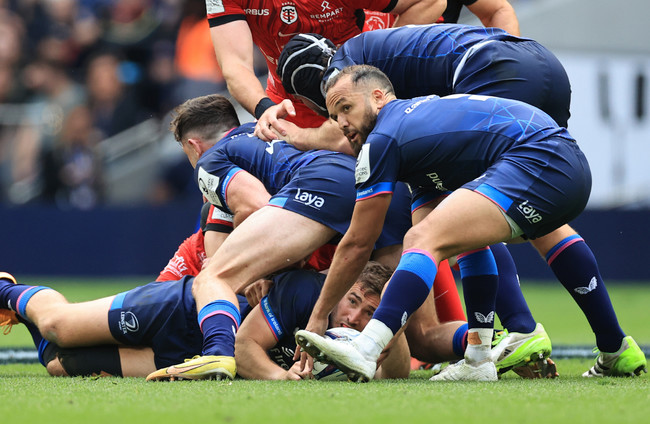THE CHAMPIONS CUP and Challenge Cup return this weekend with four tweaks to the law.
World Rugby is implementing these four amendments as ‘global law trials’ in all competitions commencing from 1 January 2025 and despite the EPCR tournaments having started last month, they will be introduced to the Champions and Challenge Cups.
EPCR hopes the changes can “promote speed, space, and contest” for the benefit of fans and players.
Match officials – including Ireland’s Eoghan Cross, who makes his Champions Cup debut as the referee for Stade Français’ clash with Northampton – will be focusing on these four areas.
Protect the scrum-half
There are a trio of elements to this change, all of which are designed to give scrum-halves more space to pass the ball away from cluttered areas.
Firstly, players like Caelan Doris will no longer be able to reach out from rucks and grab the scrum-half’s arm as in the manner below.
This confusing-looking law hack had become increasingly common in recent season, with the Champions Cup final between Leinster and Toulouse last year featuring several examples.
At that stage in May last year, World Rugby had already set the wheels in motion to outlaw this defensive play. Following trials in the U20 World Championship and elsewhere, the law trial is now in the process of being adopted in all competitions at all levels of the game.
So any defender who is, or was, part of the ruck may not play an attacking player who is near the ruck and who is attempting to play the ball away. “Near” is defined as within one metre of the ruck and the sanction is a penalty.
The change also means that defenders who are in mauls can no longer grab the attacking scrum-half as they look to play the ball away.
So any defender who is, or was, part of the maul may not play an attacking player near it and who is attempting to play the ball away. “Near” is defined as within one metre of the maul and the sanction is a penalty.
The third part of this amendment means that defensive scrum-halves can no longer come around towards the back of the attacking scrum and apply pressure there.
The defensive scrum-half can go no further than the centre line of the tunnel of the scrum made up by the two front rows.
The intention again is to clear up the back of the attacking scrum so the ball can be played away more cleanly. We’ve all seen defensive scrum-halves pouncing on their counterparts or the opposition number eight to stop a scrum attack before it even gets going, but that can’t happen anymore as they’re no longer allowed past the front rows.
These law tweaks around protecting scrum-halves were in play during last year’s Rugby Championship. Many observers probably didn’t notice much change given that the tweaks mean things cannot happen any longer, but life was a little simpler for attacking scrum-halves.
Perhaps the most noticeable change was around scrum-halves defending from scrums and the increased time the attacking side had there. So look out for the positioning of defensive scrum-halves and how teams search for new space to attack around the scrum.
Crooked throws
This change means that crooked throws won’t be called as such if the defending team doesn’t jump in the lineout.
The simple rationale here is to remove unnecessary additional stoppages in the game.
Again, this has been trialled in other competitions before now.
While getting into the air to contest lineouts could be more important than ever, given that crooked throws won’t be called up otherwise, defensive teams must still consider their maul defence and not wasting bodies by jumping for lost causes.
This change doesn’t seem likely to cause much confusion but it will be interesting if an obviously crooked throw is uncontested and the attacking team scores directly from that lineout. It may prove hard to digest for the team who concedes.
Speed up scrums and lineouts
This law trial means that match officials are being asked to enforce a 30-second set-up time for both lineouts and scrums.
30-second lineout and scrum set-ups were supposed to be part of the recent Autumn Nations Series but didn’t transpire consistently, with some scrum set-ups still taking more than a minute.
Referees have always felt the need not to rush players in such a physically demanding area of the game but the law is now demanding that they speed up the scrum, as well as reminding teams to get into the lineout within 30 seconds and avoid ‘conferences’ to discuss their calling plans.
There won’t be any countdown clocks for this, so it’s up to the match officials to manage on the pitch. No doubt some fans will have their stopwatches out in the hope that the set-pieces really do speed up.
Quicker conversions
Conversions must now be taken within 60 seconds of a try being scored, whereas previously kickers were allowed 90 seconds.
EPCR says this will be managed by an on-screen shot clock “where possible.”
The 60-second limit applies even if the ball falls off the kicker’s tee and has to be placed again.














Wish they would stop tinkering with the rules what seems every year now and just play the game .not sure giving the scrum half “more quality time” to get the ball out of the the rucks and pass or kick without having the apposing team being able to put under pressure/scupper is a good thing..surely we want attack and defense to be exiting to watch and for each play to be intensive…
@Stuart: It’s time they addressed the crooked throw in to scrums! It’s on a par with pushing and shoving in Soccer when corners being taken.
@Stuart: Rugby has Laws not rules!
@Stuart: I don’t think it’s a law change regarding scrum halves, rather more clarity around what a player in a ruck or maul can or can’t do. At the end of the day, a player who is part of a ruck is not offside even though s/he is in front of the hindmost foot. BUT s/he cannot play the ball. Therefore why should they be allowed to play the man/woman without first retreating back into an onside position. Yes, this is going to suit Dupont and gast attacking rugby… but it is the way the laws should have been interpreted in the first place.
@paddy o connor: Once there is a hook from the attacking team, play on as far as I’m concerned. Both teams get the same advantage. And defensive scrums rarely use hooking as a way to attack the ball, they attack the scrum and therefore the art is gone.
@Paul Ennis: thanks Paul, makes sense …
@Stuart: speeding up scrum and lineout set ups is a good move if applied properly. Non contested crooked throw also makes sense. They could do with cleaning up the breakdown generally, not only protecting the scrum half. A lot of ‘clearing out’ of players beyond and beside the rucks is going out which is technically illegal. It’s called tackling a player without the ball but refs are focusing on other infringements, players off feet, tacklers not releasing, etc. It’s very hard for ref to see everything so potentially this can bring a bit more clarity
@Stuart: rule changes are important to keep the game fresh. Look at games back in the 80/90s and try to stay awake.
@Michael Corkery: lots of side entries too which are completely ignored, ironic to have so much around scrum half rules – was DuPont on the committee
@Alan Keyes: I think that is a generational issue. Today, we find it difficult to keep focus for longer than 15 seconds. There are many who would relish the chance to return it to the pure spectacle it once was. Watch the scrums and lineouts – no delay just straight in; no lifting in the lineout; no reset scrums; ball in play time was higher. It wasn’t as technical and it wasn’t dominated by defence coaches. Yes, players were not as fit or as athletic but that created space for some amazing tries were the ball might go through the hands of every one of the backs. But today… I cannot remember what my original point was – It must be the referees fault!!
@Paul Ennis: nail on the head. Great post.
@paddy o connor: but it’s not an issue. The law states the putting in player must have their shoulder at the centre of the tunnel. So they can stand on their side and put in the ball. At professional level, this is enough to make the hook a non contest and 95% the put in is straight/ non material to the contest, so it is a non issue.
What about taking out a player beyond the ball/ruck ???